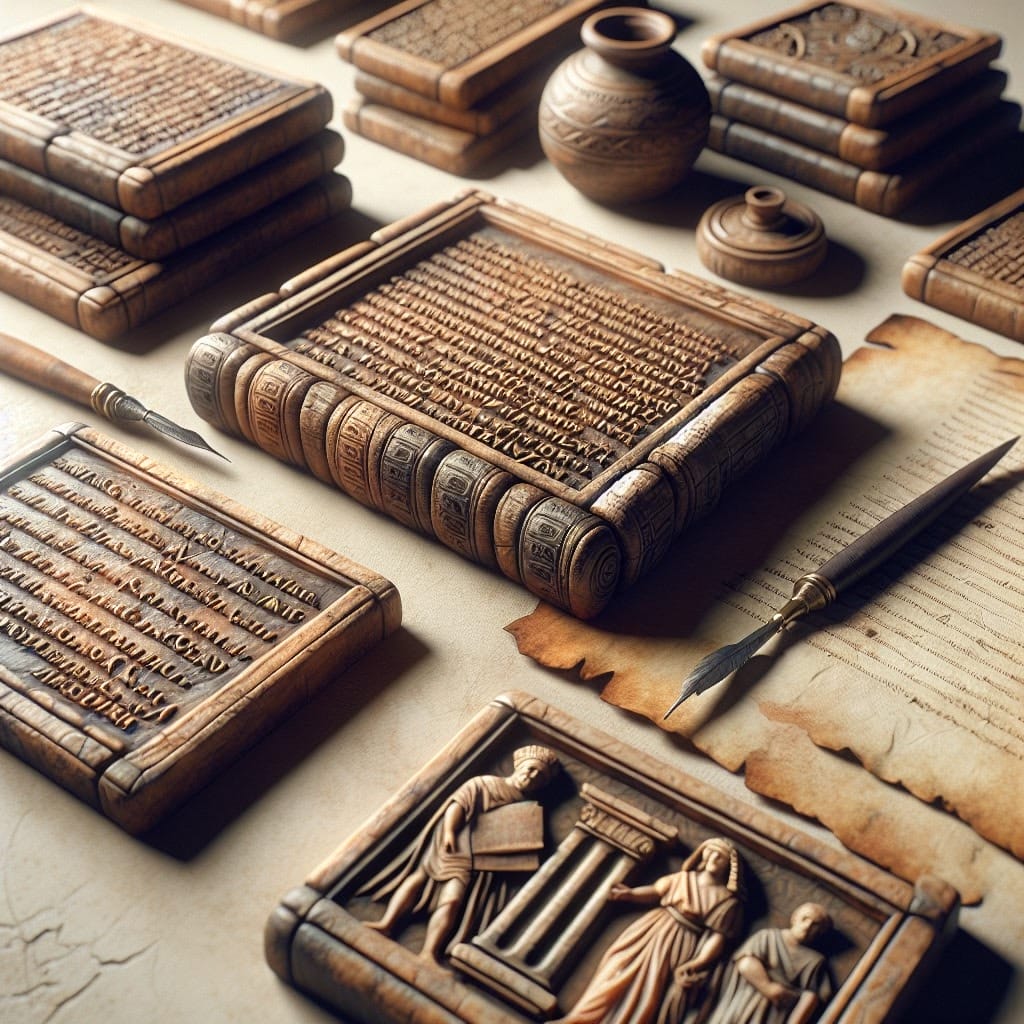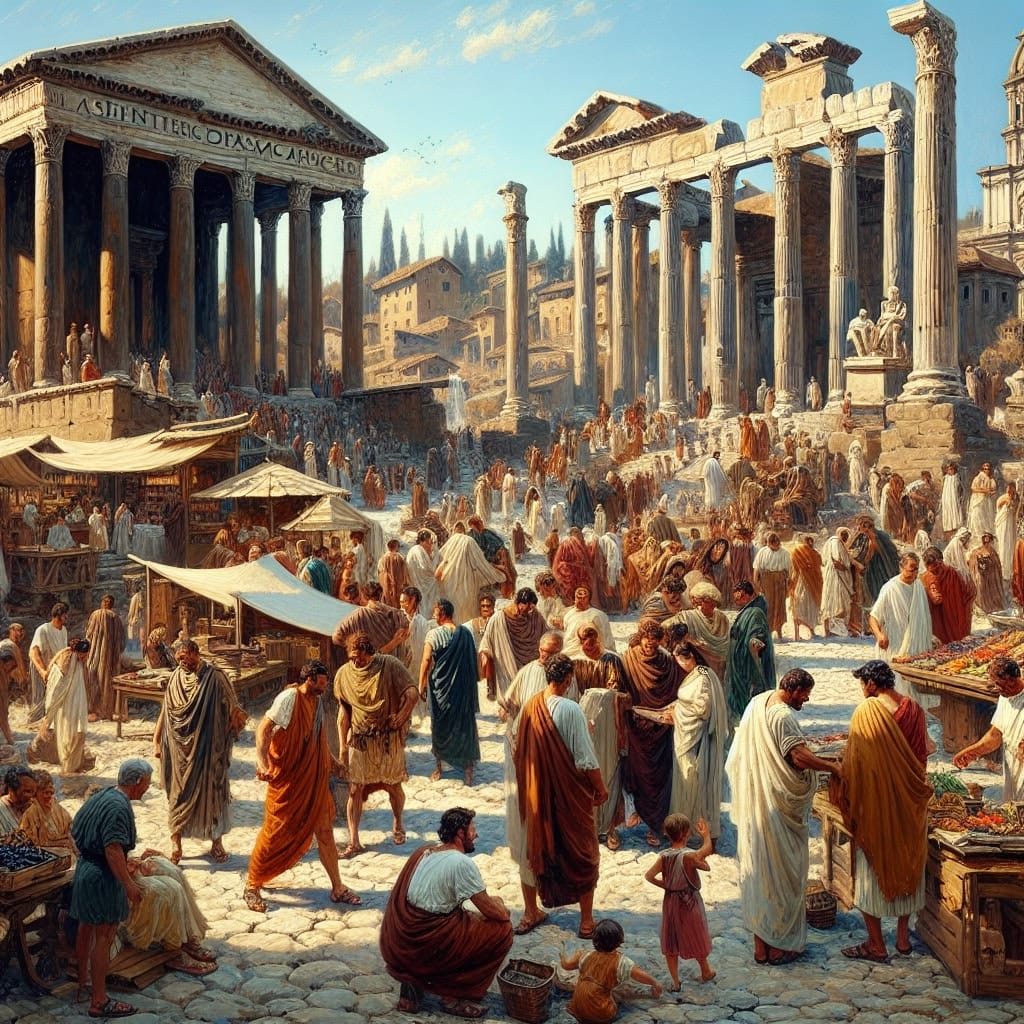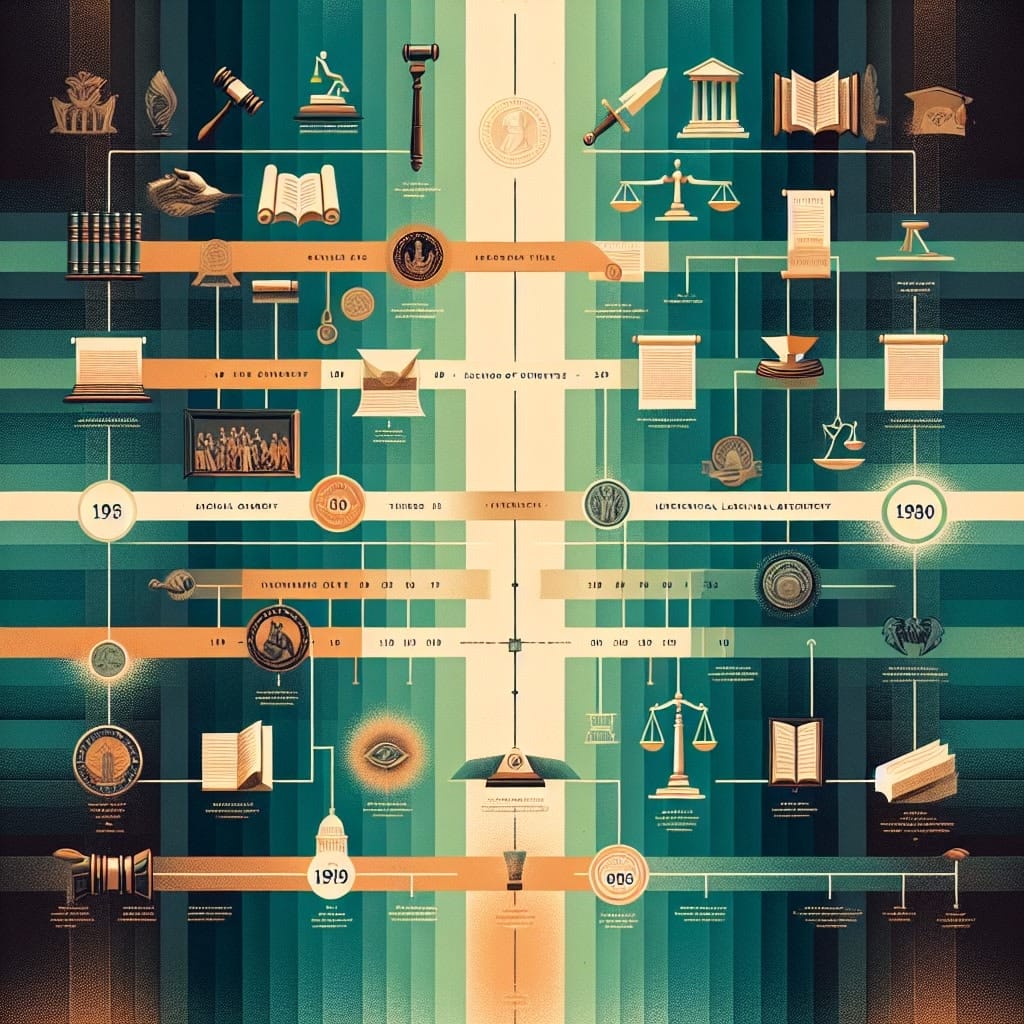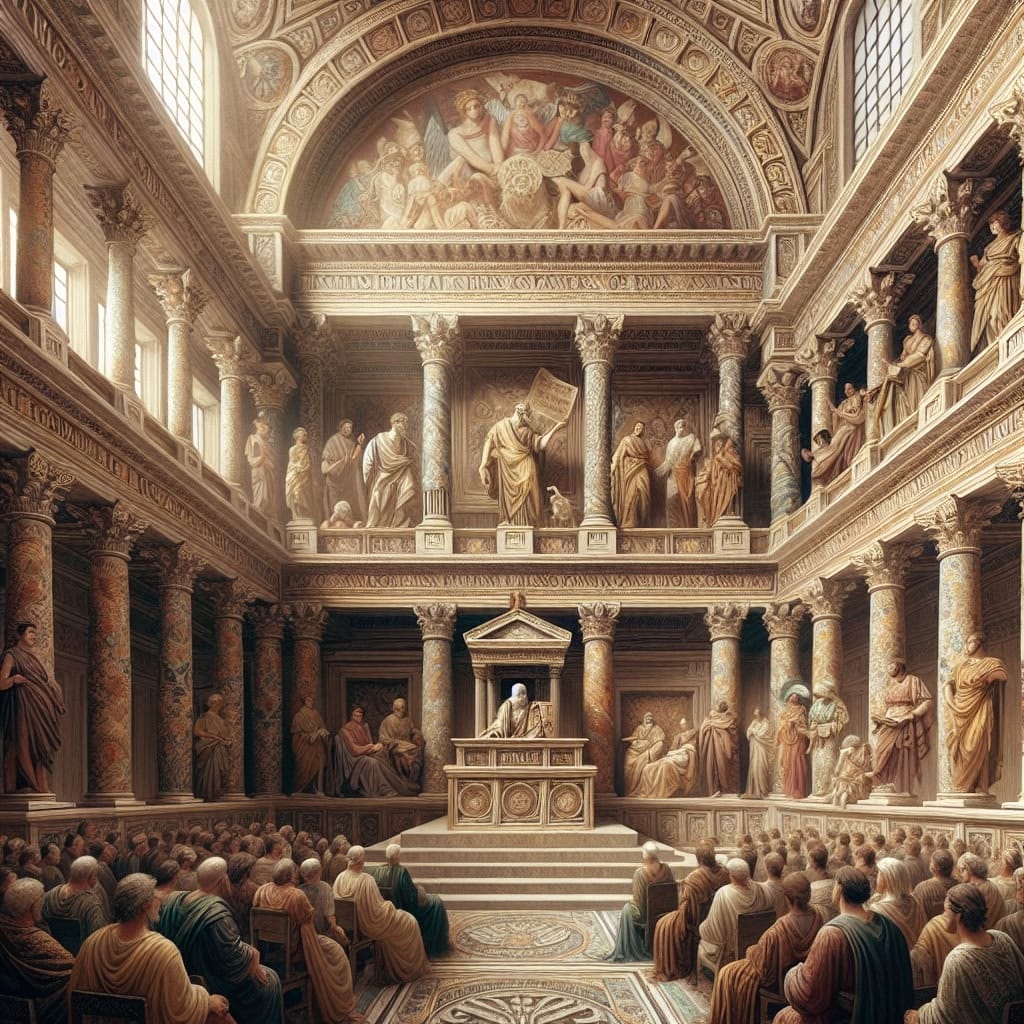The Twelve Tables stand as a cornerstone in the annals of legal history, representing ancient Rome’s first attempt at codifying laws. Crafted between 451 and 450 BC, these laws emerged from the plebeians’ demand for transparency and protection against the patrician elite. Drafted by the decemvirs, the Twelve Tables were publicly displayed in the Roman Forum, marking a pivotal shift towards written legislation. Despite their origins in preserving class privileges, they laid the groundwork for legal systems worldwide, underscoring their enduring significance.
Historical Context of Roman Law
The socio-political landscape of 5th century BC Rome was marked by intense class tension between the patricians, the wealthy elite, and the plebeians, the general citizenry. This period, known as the Conflict of the Orders, was driven by plebeians seeking greater political representation and protection from the arbitrary rule of patricians. As Rome’s government evolved, the plebeians demanded a written legal code to safeguard their rights.

The Twelve Tables were established in response to these demands, serving as Rome’s first written laws. They provided transparency and accountability, addressing issues from legal procedures to property rights. This codification was crucial for protecting plebeians from potential abuses and ensuring that the law was accessible to all, reflecting the era’s socio-political challenges.
Contents of the Twelve Tables
The Twelve Tables serve as a cornerstone of Roman law, addressing a wide array of societal issues. Each table focused on distinct legal areas, reflecting the concerns and norms of Roman society.

- Table I – Procedural Law: Outlined legal proceedings and processes.
- Table II – Additional Procedural Law: Provided further guidance on legal processes, ensuring clarity in legal actions.
- Table III – Debt: Addressed the consequences of unpaid debts, including enslavement.
- Table IV – Family Law: Governed paternal authority and family relations, reinforcing patriarchal norms.
- Table V – Inheritance: Regulated testamentary rights and inheritance laws.
- Table VI – Property: Established property rights and ownership principles.
- Table VII – Real Property: Focused on land rights and boundaries.
- Table VIII – Torts and Delicts: Covered laws related to injury and damage compensation.
- Table IX – Public Law: Addressed constitutional and public law matters, limiting certain powers.
- Table X – Sacred Law: Included regulations on religious practices and burial rites.
- Table XI – Supplementary Laws: Introduced additional laws to complement earlier tables.
- Table XII – Further Supplementary Laws: Provided further addenda to existing legal codes.
These tables not only established legal clarity but also reflected the socio-political dynamics of the time, balancing the interests of both plebeians and patricians. They were pivotal in ensuring transparency and curbing the arbitrary exercise of power by the elite.
Impact on Roman Society
The Twelve Tables heralded significant societal changes in ancient Rome by addressing the mounting tensions between the patricians and plebeians. By codifying laws, they offered transparency and fairness, which was previously absent due to unwritten customs known only to the elite. This legal clarity empowered the plebeians, allowing them to understand and assert their rights, thus reducing the arbitrary power wielded by the patricians.

In shaping Roman legal culture, the Twelve Tables served as a foundational text that influenced both citizens and governance structures. They formalized existing customs and acknowledged societal norms, such as the influence of religious practices in civil matters, thereby reinforcing the societal hierarchy while providing a framework for legal processes.
Long-term, these laws established a precedent for the transparency and accessibility of legal codes, principles that continue to underpin modern legal systems. They also facilitated the evolution of Roman governance by balancing power dynamics and laying the groundwork for future legal reforms. The Twelve Tables’ impact is evident in how they institutionalized legal proceedings, ultimately contributing to the enduring legacy of Roman law and governance.
Comparison with Modern Legal Codes
When examining the Twelve Tables alongside modern legal codes like the Code Napoléon and Germany’s Bürgerliches Gesetzbuch, several key similarities and differences emerge. Both the Twelve Tables and these modern codes underscore the importance of written laws and the accessibility of legal norms to the public.

| Aspect | Twelve Tables | Code Napoléon | Bürgerliches Gesetzbuch |
|---|---|---|---|
| Origin | 5th century BCE, Rome | 1804, France | 1900, Germany |
| Focus | Rights and duties of citizens | Individual rights and civil liberties | Private law and civil rights |
| Impact | Foundation for Roman law | Influenced European and Latin American laws | Reflects civil law tradition |
Despite their distinct historical contexts, these codes share a fundamental commitment to clarity and consistency in legal regulations. The Twelve Tables laid the groundwork for legal transparency in ancient Rome, much like the Code Napoléon and Bürgerliches Gesetzbuch continue to uphold these principles today.
Evolution of Legal Codification
Since the establishment of the Twelve Tables in ancient Rome, the process of legal codification has undergone significant evolution. The Twelve Tables marked one of the earliest attempts to create a transparent legal system accessible to all citizens. However, the true expansion of codification began with the Code of Justinian, which consolidated Roman laws and later influenced European legal systems.

During the Middle Ages, local codes and collections of maritime customs emerged, reflecting the needs of merchants and legal professionals. The introduction of national codes in Scandinavian countries heralded a new era of organized legal frameworks in Europe. The Napoleonic Code of 1804 further unified and modernized legal systems, setting a precedent for civil-law countries.
In contemporary legal systems, written laws serve as the foundation of legal rules, providing clarity and predictability. They guide legal professionals in upholding justice and adapting to societal changes. While common-law systems rely on judicial precedents, the significance of codified laws in shaping today’s legal landscape remains undeniable, ensuring that legal interpretations and applications are consistent across diverse jurisdictions.
Global Influence of Roman Legal Principles
Roman legal principles have profoundly shaped modern legal systems worldwide. The civil law system, predominant in continental Europe and parts of South America, owes much of its structure to the Corpus Juris Civilis, a cornerstone of Roman legal tradition. Countries like France, Germany, and Italy have integrated these codified statutes, reflecting the enduring legacy of Roman law.

Even in common law jurisdictions, such as those in the United Kingdom and United States, Roman concepts have left their mark. Legal precedents and principles of equity, for example, illustrate this influence. Furthermore, Roman law’s distinction between public and private law persists in contemporary legal frameworks, guiding the regulation of state matters and individual relationships.
On a global scale, Roman legal traditions have also impacted international law. The ius gentium, or law of nations, laid the groundwork for treaty law and the laws governing war and peace. This extensive reach underscores how Roman legal principles continue to inform and inspire legal systems across diverse cultures and nations.
Modern Echoes in Legal Systems
Roman legal principles continue to resonate throughout contemporary legal practices. The civil law system, prevalent in Europe and South America, is deeply rooted in Roman legal tradition, particularly through the influence of the Corpus Juris Civilis. “The architecture of modern civil codes is a testament to the enduring legacy of Roman law,” notes legal scholar Dr. Anna Leyland.

In countries such as France, Germany, and Italy, codified statutes reflect Roman influences, emphasizing a structured approach to law. Despite the distinct nature of common law systems in the UK and the US, Roman law’s impact is evident in concepts like legal precedent and equity. These principles underscore the judiciary’s role in shaping legal norms.
Moreover, the Roman distinction between public and private law remains integral to current legal frameworks. Its influence extends globally, with the ius gentium evolving into modern international law, governing state relations and commercial practices. Thus, Roman legal principles not only shape national legal systems but also lay the groundwork for international jurisprudence.
Challenges of Ancient Codification
The codification of the Twelve Tables in ancient Rome was fraught with challenges, largely due to the technological and societal limitations of the era. At the time, writing materials were rudimentary, consisting primarily of wood and metal tablets, which made the process laborious and time-consuming. Additionally, the lack of a standardized script among the Roman population posed difficulties in ensuring the accessibility and uniformity of the laws across diverse communities.

Societally, the Roman populace was not uniformly literate, which further complicated the dissemination of a codified legal text. The challenge was to create a system that was comprehensible and equitable for both the patricians and plebeians, who had differing levels of power and influence. To address these issues, the Romans employed a committee of ten officials, known as the Decemviri, tasked with drafting the laws in a manner that balanced these social dynamics.
The solutions implemented included public readings of the laws and the strategic placement of the tablets in central locations, such as the Roman Forum, to enhance public accessibility. These measures helped to ensure that the laws of the Twelve Tables were not only recorded but also integrated into the fabric of Roman society, laying a foundation for future legal systems.
Benefits of Legal Codification
The codification of laws, as exemplified by Rome’s Twelve Tables, offers numerous advantages that have resonated through time. One of the primary benefits is accessibility and clarity. By systematically arranging laws, codification makes legal texts more comprehensible to both legal professionals and the general public. This ensures that individuals can easily locate and understand the laws relevant to their circumstances.

Furthermore, codification promotes stability and consistency in legal systems. Ancient Rome achieved this by providing a unified legal framework, which reduced conflicts and ambiguities. Modern legal codes, such as France’s Code Napoléon, continue this legacy by maintaining clear and consistent legal norms.
The impact on law enforcement and societal order is also significant. Codification simplifies the enforcement process by providing a single, comprehensive document that law enforcement can easily access. This leads to increased compliance and transparency, fostering trust between citizens and the legal system. In both ancient and contemporary contexts, codification has supported societal order by streamlining legal operations and encouraging community engagement.
Limitations of Codification
While codification offers numerous benefits, it also presents certain limitations that have persisted from ancient times to modern legal systems. One notable drawback is the rigidity that codified laws can introduce. In ancient Rome, the Twelve Tables were often criticized for their inflexibility, as they did not readily adapt to new societal needs or unforeseen circumstances. This rigidity can hinder the law’s evolution and its ability to address contemporary issues.

Moreover, codified systems may sometimes fail to account for the nuances of individual cases. In modern contexts, legal systems such as Germany’s Bürgerliches Gesetzbuch (Civil Code) have faced challenges in accommodating complex case-specific details within a rigid framework. This can lead to situations where the law is applied too broadly or narrowly, lacking the nuanced interpretation often provided by case law.
Furthermore, the process of updating codified laws can be cumbersome and time-consuming. In both historical and contemporary settings, this can result in outdated laws remaining in force long after they have ceased to reflect current societal values or technological advancements. Consequently, while codification brings clarity and order, it may also struggle to maintain relevance and flexibility in a rapidly changing world.
Future of Legal Codification
The future of legal codification promises significant transformations, particularly with the integration of technological advancements. Legal scholars predict that digital tools will play a pivotal role in enhancing the accessibility and efficiency of codified laws. For instance, the use of artificial intelligence could streamline the process of updating legal codes, ensuring they remain relevant and reflect current societal norms.
Moreover, blockchain technology stands to revolutionize how laws are documented and accessed. This technology could facilitate the creation of immutable, transparent legal records that are easily accessible to the public, thus reinforcing trust in the legal system. Digital platforms could also offer dynamic, interactive legal codes that allow individuals to navigate complex legal frameworks with greater ease.
Looking ahead, scholars foresee a shift towards more inclusive and participatory codification processes. This could involve greater public engagement through online platforms, allowing citizens to contribute to the legislative discourse. Such developments would not only enhance the democratic legitimacy of legal codes but also ensure that they are grounded in the collective will of the people.
Conclusion
The Twelve Tables stand as a monumental achievement in legal history, marking one of the earliest attempts at codifying laws for public accessibility. Their significance lies in establishing a foundation for legal clarity and consistency, which has echoed through centuries. Modern legal systems, from France’s Code Napoléon to Germany’s Bürgerliches Gesetzbuch, continue to reflect the principles of accessibility and public knowledge first laid out by the Twelve Tables. Thus, they remain a testament to the enduring power of codified law in shaping societies worldwide.
FAQ on the Twelve Tables
As we explore the Twelve Tables, several questions often arise about their significance and impact. Below are some frequently asked questions to clarify common misconceptions.
- What were the Twelve Tables? The Twelve Tables were ancient Rome’s earliest attempt at a comprehensive codification of laws. Created in the 5th century BC, they served as a foundation for Roman legal tradition.
- Why were they created? The Twelve Tables were established to address the need for a transparent legal system accessible to all Roman citizens, reducing class conflict and legal disputes.
- Are any of these laws still applicable today? While the specific laws of the Twelve Tables are not in use today, their principles have influenced modern legal systems, underscoring the importance of accessibility and clarity in law.
- Did the Twelve Tables cover all aspects of life? Not entirely. While comprehensive for their time, they mainly addressed civil, procedural, and social issues pertinent to Roman society.
- Is it true that the Twelve Tables were a perfect legal system? While groundbreaking, they were not flawless. The laws evolved over time to address new societal needs and complexities, much like modern legal systems continue to do.

